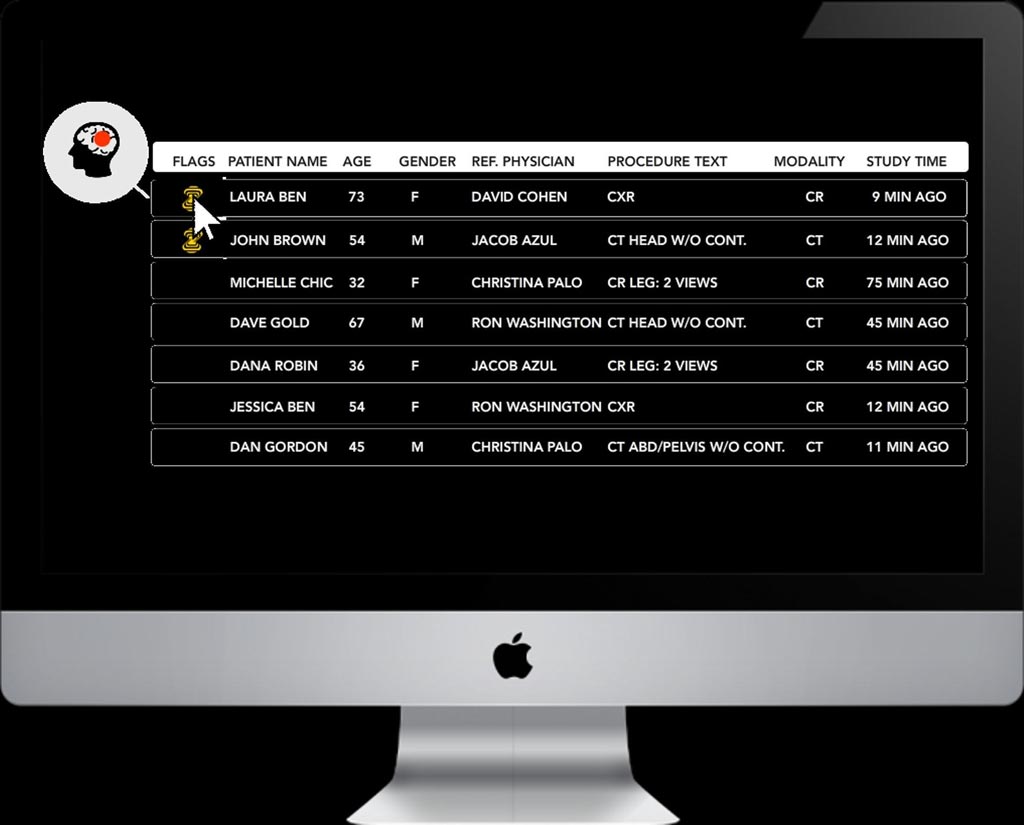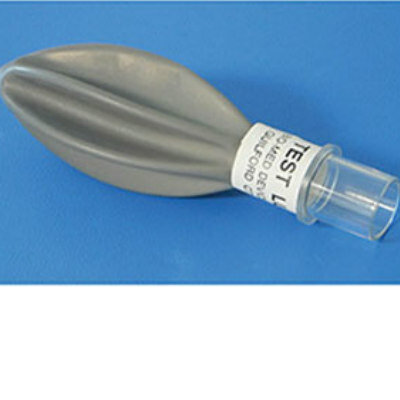Chest X-Ray AI Algorithm Warns of Pneumothorax
|
By HospiMedica International staff writers Posted on 20 May 2019 |

Image: An AI chest X-ray triage product prioritizes pneumothorax (Photo courtesy of Zebra Medical).
An artificial intelligence (AI) system automatically issues a triage alert if pneumothorax (PNX) is detected on a chest X-ray (CXR).
The Zebra Medical Vision (Shefayim, Israel) HealthPNX AI algorithm detects abnormal findings suggestive of pneumothorax based on CXR or digital radiography scans, and issues an alert to notify the medical team. The AI network was trained using millions of CXR images in order to identify over 40 common clinical findings. Subsequent validation imaging studies demonstrated high rates of agreement between the HealthPNX algorithm and human radiologists, potentially increasing their confidence in making PNX diagnosis and reducing substantially turnaround time.
In hospitals where Zebra Medical’s All-in-One (AI1) solution is integrated into the radiologist's worklist, the scan is flagged so that the radiologist can address it in a timely manner, saving physicians more than 80% of the time taken to identify the acute condition compared to traditional First In First Out (FIFO) methodology. The AI1 Triage solution also addresses another acute condition, intracranial hemorrhage, by automatically evaluating head CTs. Other Zebra Medical AI algorithms can identify patients at risk of osteoporotic fractures and cardiovascular disease (CVD).
“The pneumothorax product is a result of the extensive work accomplished by the Zebra-Med's research lab. We are happy to add this important capability to our AI1 package and add more value to busy radiology departments,” said Eyal Gura, CEO and co-founder of Zebra Medical. “Health providers across the United States that already use the many Zebra-integrated PACS and worklist systems will be able to easily deploy our triage solution and improve their patients' care and outcomes.”
Primary spontaneous pneumothorax is an abnormal accumulation of air in the pleural space that can result in the partial or complete collapse of a lung. It is likely due to the formation of small sacs of air (blebs) in lung tissue that rupture, causing air to leak into the pleural space, creating pressure that is manifest as chest pain on the side of the collapsed lung and shortness of breath. Often, people who experience a primary spontaneous pneumothorax have no prior sign of illness; the blebs themselves typically do not cause any symptoms and are visible only on medical imaging. Affected individuals may have one to more than thirty blebs.
Related Links:
Zebra Medical Vision
The Zebra Medical Vision (Shefayim, Israel) HealthPNX AI algorithm detects abnormal findings suggestive of pneumothorax based on CXR or digital radiography scans, and issues an alert to notify the medical team. The AI network was trained using millions of CXR images in order to identify over 40 common clinical findings. Subsequent validation imaging studies demonstrated high rates of agreement between the HealthPNX algorithm and human radiologists, potentially increasing their confidence in making PNX diagnosis and reducing substantially turnaround time.
In hospitals where Zebra Medical’s All-in-One (AI1) solution is integrated into the radiologist's worklist, the scan is flagged so that the radiologist can address it in a timely manner, saving physicians more than 80% of the time taken to identify the acute condition compared to traditional First In First Out (FIFO) methodology. The AI1 Triage solution also addresses another acute condition, intracranial hemorrhage, by automatically evaluating head CTs. Other Zebra Medical AI algorithms can identify patients at risk of osteoporotic fractures and cardiovascular disease (CVD).
“The pneumothorax product is a result of the extensive work accomplished by the Zebra-Med's research lab. We are happy to add this important capability to our AI1 package and add more value to busy radiology departments,” said Eyal Gura, CEO and co-founder of Zebra Medical. “Health providers across the United States that already use the many Zebra-integrated PACS and worklist systems will be able to easily deploy our triage solution and improve their patients' care and outcomes.”
Primary spontaneous pneumothorax is an abnormal accumulation of air in the pleural space that can result in the partial or complete collapse of a lung. It is likely due to the formation of small sacs of air (blebs) in lung tissue that rupture, causing air to leak into the pleural space, creating pressure that is manifest as chest pain on the side of the collapsed lung and shortness of breath. Often, people who experience a primary spontaneous pneumothorax have no prior sign of illness; the blebs themselves typically do not cause any symptoms and are visible only on medical imaging. Affected individuals may have one to more than thirty blebs.
Related Links:
Zebra Medical Vision
Latest AI News
Channels
Critical Care
view channel
Light-Based Technology to Measure Brain Blood Flow Could Diagnose Stroke and TBI
Monitoring blood flow in the brain is crucial for diagnosing and treating neurological conditions such as stroke, traumatic brain injury (TBI), and vascular dementia. However, current imaging methods like... Read more
AI Heart Attack Risk Assessment Tool Outperforms Existing Methods
For decades, doctors have relied on standardized scoring systems to assess patients with the most common type of heart attack—non-ST-elevation acute coronary syndrome (NSTE-ACS). The GRACE score, used... Read moreSurgical Techniques
view channel
Minimally Invasive Endoscopic Surgery Improves Severe Stroke Outcomes
Intracerebral hemorrhage, a type of stroke caused by bleeding deep within the brain, remains one of the most challenging neurological emergencies to treat. Accounting for about 15% of all strokes, it carries... Read more
Novel Glue Prevents Complications After Breast Cancer Surgery
Seroma and prolonged lymphorrhea are among the most common complications following axillary lymphadenectomy in breast cancer patients. These postoperative issues can delay recovery and postpone the start... Read morePatient Care
view channel
Revolutionary Automatic IV-Line Flushing Device to Enhance Infusion Care
More than 80% of in-hospital patients receive intravenous (IV) therapy. Every dose of IV medicine delivered in a small volume (<250 mL) infusion bag should be followed by subsequent flushing to ensure... Read more
VR Training Tool Combats Contamination of Portable Medical Equipment
Healthcare-associated infections (HAIs) impact one in every 31 patients, cause nearly 100,000 deaths each year, and cost USD 28.4 billion in direct medical expenses. Notably, up to 75% of these infections... Read more
Portable Biosensor Platform to Reduce Hospital-Acquired Infections
Approximately 4 million patients in the European Union acquire healthcare-associated infections (HAIs) or nosocomial infections each year, with around 37,000 deaths directly resulting from these infections,... Read moreFirst-Of-Its-Kind Portable Germicidal Light Technology Disinfects High-Touch Clinical Surfaces in Seconds
Reducing healthcare-acquired infections (HAIs) remains a pressing issue within global healthcare systems. In the United States alone, 1.7 million patients contract HAIs annually, leading to approximately... Read moreHealth IT
view channel
Printable Molecule-Selective Nanoparticles Enable Mass Production of Wearable Biosensors
The future of medicine is likely to focus on the personalization of healthcare—understanding exactly what an individual requires and delivering the appropriate combination of nutrients, metabolites, and... Read moreBusiness
view channel
Philips and Masimo Partner to Advance Patient Monitoring Measurement Technologies
Royal Philips (Amsterdam, Netherlands) and Masimo (Irvine, California, USA) have renewed their multi-year strategic collaboration, combining Philips’ expertise in patient monitoring with Masimo’s noninvasive... Read more
B. Braun Acquires Digital Microsurgery Company True Digital Surgery
The high-end microsurgery market in neurosurgery, spine, and ENT is undergoing a significant transformation. Traditional analog microscopes are giving way to digital exoscopes, which provide improved visualization,... Read more
CMEF 2025 to Promote Holistic and High-Quality Development of Medical and Health Industry
The 92nd China International Medical Equipment Fair (CMEF 2025) Autumn Exhibition is scheduled to be held from September 26 to 29 at the China Import and Export Fair Complex (Canton Fair Complex) in Guangzhou.... Read more
















